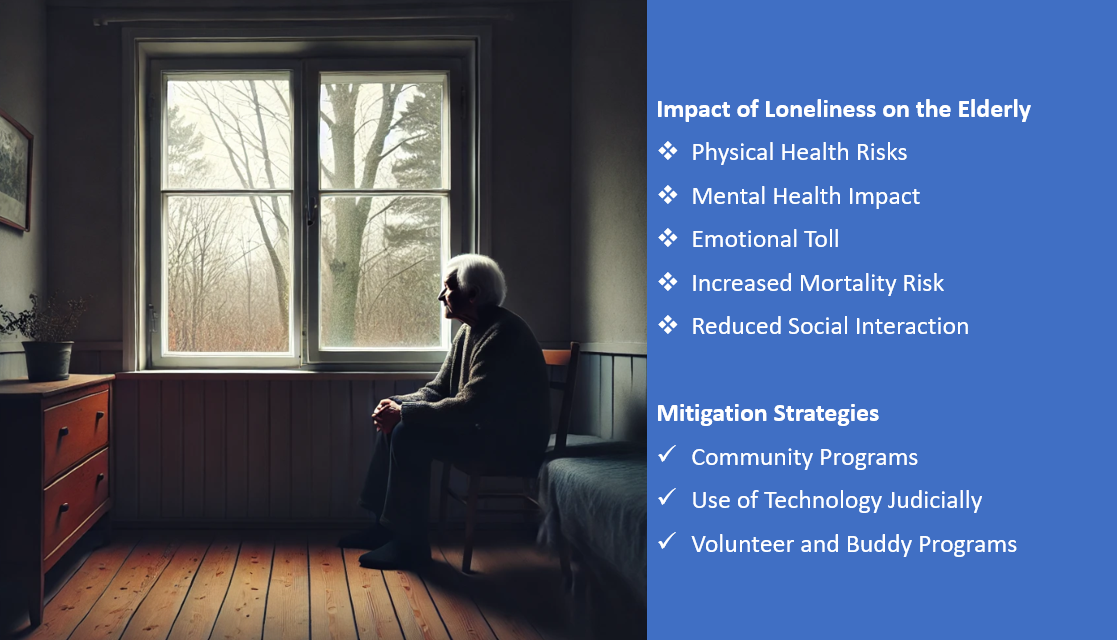Loneliness and social isolation are growing concerns for older adults, and they pose significant risks to physical, mental, and emotional well-being. With increasing life expectancy, many elderly individuals live alone or are geographically distant from family and friends. The effect of this social disconnection can be profound, leading to a range of health complications and a diminished quality of life.
Physical Health Impact
Loneliness and isolation can directly influence physical health in older adults, contributing to:
- Increased Risk of Chronic Illness: Research shows that socially isolated elders are at a higher risk of developing chronic conditions such as heart disease, hypertension, and diabetes. This may be linked to the stress and reduced activity that often accompanies loneliness.
- Weakened Immune System: Loneliness can cause increased levels of cortisol (a stress hormone), leading to a weakened immune system, making the elderly more susceptible to infections and illnesses.
- Higher Mortality Rates: Multiple studies have found that chronic loneliness and isolation are associated with an increased risk of premature death. This is often compared to the risk of other well-known health risks, such as smoking or obesity.
Mental and Emotional Well-being
The emotional toll of isolation and loneliness is significant, often leading to:
- Depression and Anxiety: A lack of social interaction can result in increased feelings of sadness, despair, and anxiety. Elderly people who experience prolonged loneliness are at a higher risk of developing clinical depression, which is often underdiagnosed in this age group.
- Cognitive Decline: Social engagement is an important factor in maintaining cognitive function. Isolation has been linked to faster rates of cognitive decline, including memory loss and a higher risk of developing dementia or Alzheimer’s disease.
- Loss of Purpose: Older adults who are isolated may feel disconnected from society and experience a loss of purpose, which can exacerbate feelings of worthlessness or hopelessness.
Social and Behavioral Impact
- Reduced Participation in Social Activities: As loneliness becomes more entrenched, older adults may withdraw even further from the few social opportunities they have. This can create a cycle where isolation leads to more isolation.
- Risk of Elder Abuse: Socially isolated elderly individuals are at a greater risk of elder abuse, as they may not have trusted family or friends around to monitor their well-being or advocate for them.
Mitigation Strategies
Addressing loneliness and isolation in older adults requires both societal and individual efforts, including:
- Community Programs: Local and national initiatives such as senior centers, social clubs, and volunteer programs can help create social opportunities for older adults. Intergenerational programs, where youth engage with older adults, have also shown promising results.
- Technological Solutions: The increasing availability of digital tools such as video calls, social media, and online community groups has provided some relief for isolated elders. Training older adults in the use of these technologies can enhance their social engagement.
- Healthcare Interventions: Physicians and healthcare providers can play a critical role by screening for loneliness during regular checkups and referring patients to social support programs.
- Policy and Infrastructure: Governments can develop policies that encourage affordable housing, accessible transportation, and healthcare services tailored to the social needs of the elderly, helping to reduce the structural causes of isolation.
Conclusion
Loneliness and isolation pose serious risks to the elderly, affecting their physical, mental, and emotional health. With the growing elderly population, it is crucial to implement supportive measures to address these issues. By fostering community engagement, improving access to social services, and using technological innovations, we can help mitigate the negative effects and improve the overall quality of life for seniors.



